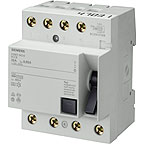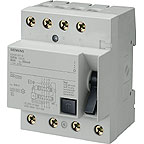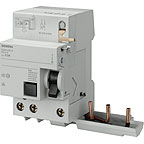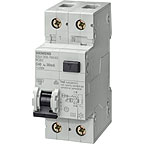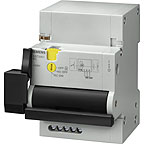RCCBs of type A are used in all systems up to 240/415 V AC. They trip in the event of both sinusoidal AC residual currents and pulsating DC residual currents.
RCCBs with a rated residual current of maximum 30 mA are used for personnel, material and fire protection, as well as for additional protection against direct contact. RCCBs with a rated residual current of 10 mA are primarily used in areas that represent an increased risk for personnel. Devices with a rated residual current of maximum 300 mA are used as preventative fire protection in case of insulation faults.
Instantaneous devices have a surge current withstand capability with current waveform 8/20 μs of more than 1 kA, super resistant of more than 3 kA and selective of more than 5 kA. This ensures safe operation.
The patented RCCB SIGRES has built-incondensation protection to ensure maximum safety and durability even under harsh conditions such as gas or moisture in the ambient air.
RCCBs of type A are used in all systems up to 240/415 V AC. They trip in the event of both sinusoidal AC residual currents and pulsating DC residual currents.
RCCBs with a rated residual current of maximum 30 mA are used for personnel, material and fire protection, as well as for additional protection against direct contact. RCCBs with a rated residual current of 10 mA are primarily used in areas that represent an increased risk for personnel. Devices with a rated residual current of maximum 300 mA are used as preventative fire protection in case of insulation faults.
Instantaneous devices have a surge current withstand capability with current waveform 8/20 μs of more than 1 kA, super resistant of more than 3 kA and selective of more than 5 kA. This ensures safe operation.
The patented RCCB SIGRES has built-incondensation protection to ensure maximum safety and durability even under harsh conditions such as gas or moisture in the ambient air.
Frequency converters, medical devices and UPS systems are seeing increasing use in industry. Smooth DC residual currents or currents with low residual ripple may occur in the event of faults on these devices.
Type A residual current protective devices are unable to detect these smooth DC residual currents.
Universal current-sensitive residual current protective devices of Type B have an additional transformer, which is supplied with a control signal. It is therefore possible to evaluate the change of the transformer's operating range caused by smooth DC residual currents, thus ensuring the desired protective function.
The devices in this series are designed as residual current operated circuit breakers (RCCBs) up to 80 A and as residual current circuit breakers with integral over current protection (RCBOs) for 100 A or 125 A in Characteristics C or D.
Frequency converters, medical devices and UPS systems are seeing increasing use in industry. Smooth DC residual currents or currents with low residual ripple may occur in the event of faults on these devices.
Type A residual current protective devices are unable to detect these smooth DC residual currents.
Universal current-sensitive residual current protective devices of Type B have an additional transformer, which is supplied with a control signal. It is therefore possible to evaluate the change of the transformer's operating range caused by smooth DC residual currents, thus ensuring the desired protective function.
The devices in this series are designed as residual current operated circuit breakers (RCCBs) up to 80 A and as residual current circuit breakers with integral over current protection (RCBOs) for 100 A or 125 A in Characteristics C or D.
RC units of type A can be used in all systems up to 240/415 V AC. They trip in the event of both sinusoidal AC fault currents and pulsating DC residual currents.
RC units are combined with miniature circuit breakers with characteristics A, B, C and D, provided that these are available in the MCB range. The two components are simply plugged together without the need for any tools.
Then they form a combination of RCCB and MCB for personnel, fire and line protection.
Super resistant
Super resistant (short-time delayed) RC units satisfy the maximum permissible break times for instantaneous devices. However, by implementing a short-time delay they prevent unnecessary trippings, and thus plant faults, when pulse-shaped leakage currents occur - as is the case when capacitors are switched on.
Selective
All devices have surge current withstand capability of more than 1 kA, thus ensuring safe and reliable operation
RC units of type A can be used in all systems up to 240/415 V AC. They trip in the event of both sinusoidal AC fault currents and pulsating DC residual currents.
RC units are combined with miniature circuit breakers with characteristics A, B, C and D, provided that these are available in the MCB range. The two components are simply plugged together without the need for any tools.
Then they form a combination of RCCB and MCB for personnel, fire and line protection.
Super resistant
Super resistant (short-time delayed) RC units satisfy the maximum permissible break times for instantaneous devices. However, by implementing a short-time delay they prevent unnecessary trippings, and thus plant faults, when pulse-shaped leakage currents occur - as is the case when capacitors are switched on.
Selective
All devices have surge current withstand capability of more than 1 kA, thus ensuring safe and reliable operation
RCBOs are a combination of an RCCB and a miniature circuit breaker in a compact design for personnel, fire and line protection. For personnel and fire protection, the residual current part of the type A trips in the event of sinusoidal AC residual currents and pulsating DC residual currents.
The MCB part of the RCBO protects lines against overload and short circuits and is available in characteristics B and C.
RCBOs are a combination of an RCCB and a miniature circuit breaker in a compact design for personnel, fire and line protection. For personnel and fire protection, the residual current part of the type A trips in the event of sinusoidal AC residual currents and pulsating DC residual currents.
The MCB part of the RCBO protects lines against overload and short circuits and is available in characteristics B and C.
- Auxiliary switches (AS) signal the contact position of the RCCB.
- Remote controlled mechanisms are used for the remote ON/OFF switching of RCCBs. They also enable local manual switching. A tripped RCCB must be acknowledged prior to switching back on.
- The leakage current measurement device detects the leakage currents thus providing a direct statement as to the current loading of the RCCB. It is used to measure leakage currents up to 300 mA.
- Bus systems, such as instabus KNX, AS-Interface bus or PROFIBUS, can be integrated in the communication over binary inputs
- Auxiliary switches (AS) signal the contact position of the RCCB.
- Remote controlled mechanisms are used for the remote ON/OFF switching of RCCBs. They also enable local manual switching. A tripped RCCB must be acknowledged prior to switching back on.
- The leakage current measurement device detects the leakage currents thus providing a direct statement as to the current loading of the RCCB. It is used to measure leakage currents up to 300 mA.
- Bus systems, such as instabus KNX, AS-Interface bus or PROFIBUS, can be integrated in the communication over binary inputs
Baouchrieh - Metn
2616 5311 Lebanon
P.O.BOX 11-0242 Riad El Solh-Beirut
1107 2020 Lebanon
Beirut, Lebanon
SOCIAL
WITH US !



